If you’ve traveled to the North Caucasus before, there is a good chance you’ve already been to Kabardino-Balkaria, and you didn’t even know it! Kabardino-Balkaria lies in the center of the North Caucasus region, is home to Mt. Elbrus, but more than that is a treasure chest of travel possibilities. Here is our guide to traveling through the republic of Kabardino-Balkaria, or 9 travel tips to this beautiful land:
1. How do I get there?
Kabardino-Balkaria hosts a large number of both foreign and Russian travelers every year, and has an improving infrastructure able to handle the incoming masses. Let’s start with the obvious. You might be a mountain climber or skier coming to enjoy the slopes of Mt. Elbrus. That means you’re likely arriving on an airplane to Russia. Here are your travel options:
A. Plane – We advise you fly into the Mineralni Vodi (MRV) airport in the Stavropol Region, which is about 45 minutes from the border of Kabardino-Balkaria. MRV is the largest airport in the North Caucasus, and has daily direct flights to and from all 3 airpots in Moscow (SVO, DME, and VKO), direct flights from St. Petersburg, and several international flight routes as well, including from Istanbul, Dubai, Greece, Tel Aviv, and Bishkek. The MRV airport has a growing infrastructure and is the most obvious choice to fly into if going to Elbrus. From MRV, it’s a 2 hr. drive to Nalchik, and a 3.5 hr. drive to Mt. Elbrus.
That being said, the capital of Kabardino-Balkaria, Nalchik (NAL), also has a small regional airport with a daily flight to/from Moscow as well as weekly flights to Istanbul. As is to be expected in most smaller, regional airports around Russia, the service standard at a small airport like this will be minimal. As a result, we recommend you flying in and out of MRV if able. It’s a 2 hr. drive to Elbrus from Nalchik. You can also fly into other regional airports which are 2 hrs. from Nalchik, such as OGZ in North Ossetia (Vladikavkaz) or IGT in Ingushetia (Magas).
B. Car/Public Transport – If you have a car, are using a taxi, or are hitch-hiking your way to Kabardino-Balkaria, the region is accessible by a variety of roads and vehicles. A major Russian federal highway E50 runs through Pyatigorsk into Kabardino-Balkaria, and can take you towards Mt. Elbrus, Nalchik, and deeper into the North Caucasus. There are daily mini-buses, or “marshrutkas”, that travel to Nalchik from Pyatigorsk, Vladikavkaz, Grozny, and Magas, if you’re coming from a neighboring republic. From the main Nalchik bus station, there is a marshrutka that goes to Terskol (i.e. Mt. Elbrus) daily around 12:30 pm; for that matter, marshrutkas run daily into every valley of this beautiful republic. For the seasoned international traveler, you can drive from the country of Georgia up the famed “Georgian Military Highway” through the heart of the Caucasus Mountains, cross the border into Russia at the “Verkhni Lars” border stop, and be in Nalchik in about 2.5 hours as well.
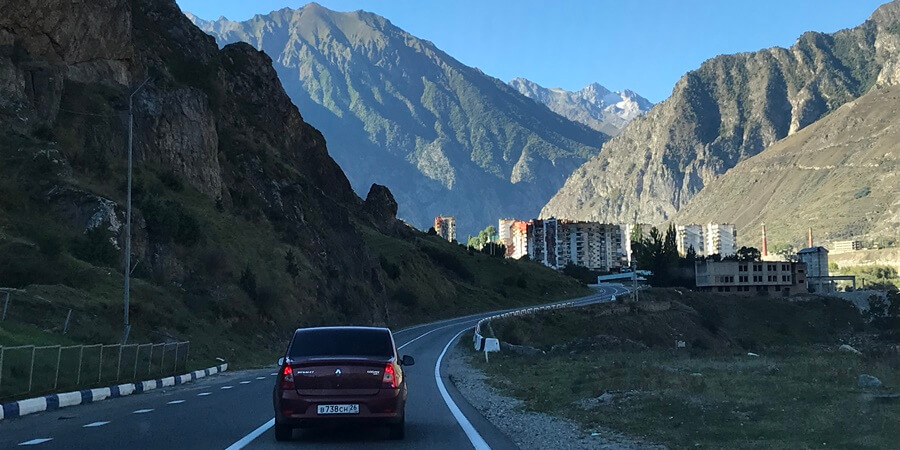
Anyone traveling on their own should download the “Yandex” taxi app, which is Russia’s version of Uber, and has a very user-friendly app with affordable prices. In smaller villages/towns where Yandex’s service doesn’t reach, just ask a local and they’ll direct you to a friend or relative who can taxi you where you need to go!
C. Train – Kabardino-Balkaria is also very accessible by the famous cross-country Russian train system if that’s your preferred method of travel. Almost all trains to the North Caucasus pass through Mineralni Vodi in the Stavropol region to the north, so make sure wherever you are coming from, Mineralni Vodi is one of the stops. Despite Nalchik having a train station, the city is about 45 minutes from the main railway route that runs diagonal through the North Caucasus, and as a result it’s a bit convoluted to get a train directly to Nalchik. That being said, the town Prokhladni is a regular stop on trains going to/coming from Baku, Makhachkala, Grozny, Nazran, and Vladikavkaz, so you can always hop off there and find your way by public transport or taxi.
2. What are the best places to stay?
This list could get exhaustive, fast. 🙂 Let’s first look at an overview of the republic’s geography, followed by hotel recommendations:
A. Nalchik – This is the capital city of Kabardino-Balkaria, with a population of around 250,000. Nalchik is growing and new, modern hotels are being built regularly. Here are some of our recommendations:
-Modern and comfortable: Azimut, Butik Otel
-Budget with less frills: Hotel Rossia, Korona
You could comfortably spend a week in Nalchik, while doing day trips into Kabardino-Balkaria’s beautiful mountain valleys.
B. Baksan Valley – This is the most traveled road in Kabardino-Balkaria, the road to Mt. Elbrus. If you have questions about its safety because of travel warnings, please see our detailed blog here of the drive to erase any doubts or fears. Needless to say, because of the draw of Mt. Elbrus, there are a huge variety of lodging options at the end of this valley, from 4-star to mid-range to budget to hostel. Here are just a few we’ll recommend from our experience:
-Modern and comfortable 4-star-ish: Azau Star, Kristall 139
-Budget with less frills 3-star-ish: Laguna, Povorot
If you’re a mountain climber with your sites set on the summit of Elbrus, you’ll have to spend at least 3-4 nights at Elbrus’s famous base camp at 13,000 feet. The “barrel huts” are not easy to book directly with, and we highly recommend you do your climb (and hence, have your bookings handled) through a trusted climbing company. Here are two shelters at base camp we recommend:
-Modern and comfortable: Leaprus
-Budget with less frills: Heart of Elbrus Lodge
If you’re interested in climbing Mt. Elbrus and staying in these barrel huts, click here to see our climbing itineraries, pricing, and group dates.
C. Chegem Valley – Chegem Valley is the adjacent valley to Elbrus’s Baksan Valley, and is famous for its beautiful waterfalls as well as being Russia’s top paragliding location. The “Paradrome” has modest accommodations for those wanting to get to know this beautiful valley for a longer period of time.
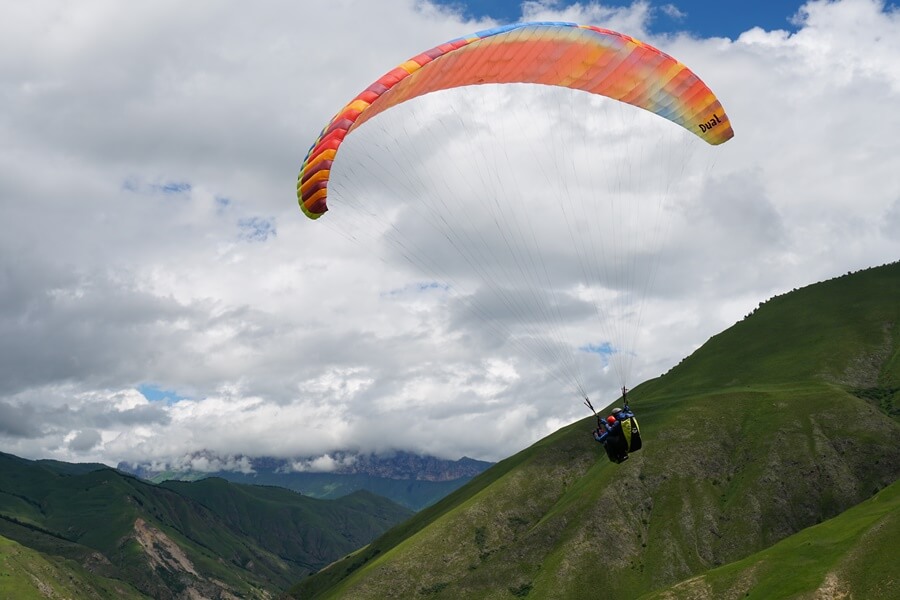
D. Upper Balkaria, or Cherek Valley – This is another beautiful mountain gorge not too far from Nalchik. There is an authentic lodging complex in Upper Balkaria called Tau-El, with amazing local food for meals as well.

E. Border Zone lodging – Several of Kabardino-Balkaria’s mountain gorges run into the border zone with neighboring country Georgia, i.e. an area that foreigners cannot enter without a special permit from the local government (often taking 2 months to receive). There is a famous mountaineering lodge in Bezengi Valley, where several generations of Russian mountain climbers have honed their craft in the Caucasus Mountains. Perpendicular to Baksan Valley (about 25 minutes from the base of Mt. Elbrus) is Adyr-Suu Valley, where there is a lodge for back-country skiers to stay, while trying their hands (and feet!) on the untouched snow of that valley. Both these valleys require border permits for foreigners, but are possible to access for the more adventurous!
3. Top cities to visit?
Most locals would agree that Nalchik is the main city of significance to visit in Kabardino-Balkaria, but let’s be honest, even more would say, “Just go to the mountains!” Tirnauz is the capital of the Elbrus district, and is an interesting town to spend some time in, with its unique location in the mountains and place in Soviet history as a once-booming mining town. The main thing to consider in visiting Nalchik and other cities in the lowlands, is the chance to experience Kabardian culture and food. Whereas the deeper you go into the valleys, the more you’ll encounter Balkar culture and food.
4. Best local foods to try?
There are 3 types of food that come to mind, when spending time in Kabardino-Balkaria:
A. Khychiny – This is one of the staple national dishes of the Balkar people, and what you’ll inevitably be served if guests of local Balkars. It’s a thin buttery flat bread, sometimes cooked with fillings of cottage cheese, fresh greens, or potatoes. It is often slathered in butter, but wow is that some tasty greasy goodness! 🙂

B. Shashlik – Shashlik is a MUST for any visit anywhere in the North Caucasus! Most people would agree that it’s the national food of the entire region. Shashlik is meat shish kabobs; while pork and turkey can be found in some parts of the Caucasus, lamb or chicken are the preferred shashlik meats of choice in Kabardino-Balkaria.
C. Soup – No matter where you are in Russia, you’re sure to find a local soup that people love. Kabardino-Balkaria is no different. Especially in the winter months in the mountain valleys, there’s nothing better than to come inside from the cold weather and warm your body up to a bowl of hearty Caucasus soup. Whether Georgian kharcho or local Balkar lakhman, make sure to try your hand at one of these soups with a side of fresh baked bread/lavash!
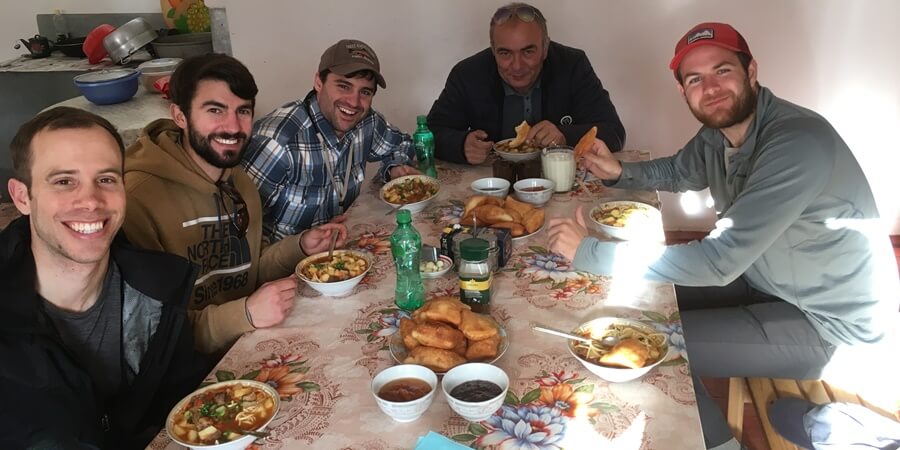
5. Top Hole-In-The-Wall restaurants:
Of course, for a republic of this size, we’re bound to leave at least a few great local joints off our list, but here are a few to get you started. ***Note: Restaurants in the North Caucasus are much better known for their food than their service, so prepare for tasty food, but manage your expectations about service:
-Elbrus – Kogutai Restaurant at Mt. Cheget – While this isn’t a hole-in-the-wall restaurant per se, it’s one of many to choose from in the Cheget tourist village, and we have found them to provide consistently good food and service. Kogutai has a nice interior, and maybe most important, an English-language menu with good pictures. 🙂 There also is a nice outdoor patio with fantastic views of the surrounding mountains.
-Nalchik #1 – Tameris Restaurant – This is a cafe with a relaxed atmosphere in the capital Nalchik. Local tour company Elbrus Elevation has taken foreign groups there on multiple occasions and always had good experiences. Address is ul. Kuliyeva 3.
-Nalchik #2 – Cafe-Bar Oasis – You have to know where this restaurant is to find it, but once inside, you won’t regret it! There is a unique cafeteria-style ordering process, that includes several dishes being cooked on the spot once ordered. You can sample local Kabardian dishes here. The seating area is very modern and a pleasant atmosphere to have a meal in. Address is ul. Kuliyeva 2.
-Upper Balkaria – Tau-El Restaurant – This is the restaurant part of the Tau-El Tourist Complex in Upper Balkaria. Whether spending the night or just passing through, make sure to stop here for a meal!
6. Must-See Sites
This republic is so chock full of “must-see” destinations, it’s impossible to narrow the list down. Here are just a few suggestions to get you started: (***Mt. Elbrus is a no-brainer and we’re assuming that’s on your list)
A. El-Tyubu and Paradrome – This is an amazing area towards the end of Chegem Valley. Many tourists visit the famous Chegem Waterfalls and don’t drive any further down this gorge, which really is a shame. El-Tyubu is a picturesque Balkar village with several historical sites to see, including some ancient mausoleums. The real gem of the area, though, is the Paradrome, which is Russia’s premier paragliding destination. The combination of the scenic surrounding mountains and constant winds produces almost daily conditions to sail through the beautiful Caucasus sky. Highly recommend!
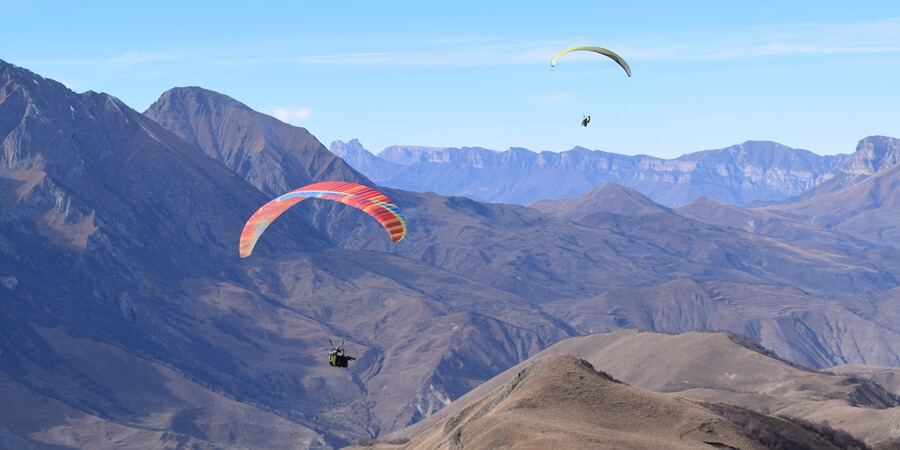
B. Upper Balkaria – Also known as Cherek Valley, the entire drive to the actual village of Upper Balkaria is one big destination. First, you can spend time at the 3 consecutive “Blue Lakes”, one of which is one of Russia’s deepest lakes with an underground spring. Then, the drive itself becomes an adventure, as you pass by steep rock walls with a huge drop-off on the other side. If you’re able to walk this part of the road, that is a bonus! Once you’ve made your way through the valley walls, the region opens up into a beautiful panoramic view. Many years ago, there were multiple villages in this region, but they’ve since been condensed into one main village. You can see some of the ancient Balkar towers that their ancestors used to live in as well.
C. Djili-Suu – Although hard to pronounce and not easy to get to, Djili-Suu is one of those places in the North Caucasus that people rave about that you “have to” visit. It’s actually on the North side of Mt. Elbrus, and more accessible from the Mineral Waters region (2 hrs. from Kislovodsk). The base camp for Elbrus climbers summiting the mountain from the North side is at Djili-Suu. This area is famous in Russia for its numerous natural healing springs, as well as unique climate conditions that make for beneficial, long holidays for seeking a respite from their daily grind. There are wide swaths of land available for camping, with probably the most unrivaled views of Mt. Elbrus in the North Caucasus. Make sure to check this out!
7. Off-the-beaten path destinations

A. King’s Waterfalls (Tsarskie), or Gedmisht – Probably the valley in Kabardino-Balkaria with the least amount of hype is the Malka Valley, which is the northernmost valley and mainly runs through the Kabardian lowlands. At the point where the villages end, though (Khabas), the asphalt turns into dirt and the hills start to rise, culminating with the incredible King’s Waterfalls, or as one friend put it, Avatar Waterfalls. These stunning waterfalls are best visited in the early summer, when everything is lush green and the water flow is strong, with many streams of water flowing down the earth’s surface. The different colors are incredible and it’s hard to look away. Once you’ve enjoyed the waterfalls, enjoy a meal of shashlik at one of the nearby lunch huts. Having an off-road vehicle is ideal to visit these falls, but worth the time and effort!
B. One-seater chair lift at Elbrus – As the infrastructure at Mt. Elbrus has modernized, some of the more “authentic” experiences have gone to the way-side. This is one experience still available, though! From the 2nd (11,000 ft.) to 3rd level (12,500 ft.) of Mt. Elbrus (whether skiing, going to base camp, or just touring), there is a single-seater chair lift for 100 rubles each way (less than $2). This is an amazing experience if you have the time. It’s 8-10 minutes each way, and a surreal experience of the majestic Caucasus mountain range surrounding you, skiers silently passing you by underneath, and in general enjoying the silent expanse of nature all around. The chair lifts are from the Soviet times and so it feels like something from a different era. For mountain climbers, the newer group cable car gives better access to most of base camp, but several huts are pretty close to this chair lift, so it still may be a good option for you.
C. Abandoned Mines above Tirnauz – Tirnauz is about 1 hr. from Mt. Elbrus, and a town everyone drives through to and from the mountain. Although today it looks old and half-abandoned, it was a booming mining town in the 20th century. About a 45-minute drive above the city with an off-road vehicle, you can see the remains of the mining operations. Learning about this history combined with the breath-taking views of the Baksan Valley and even into Georgia, you’ll wonder why more people aren’t visiting this place. This is a great spot to see eagles soaring in the sky, as well as admire the Soviet city plan of Tirnauz from above.
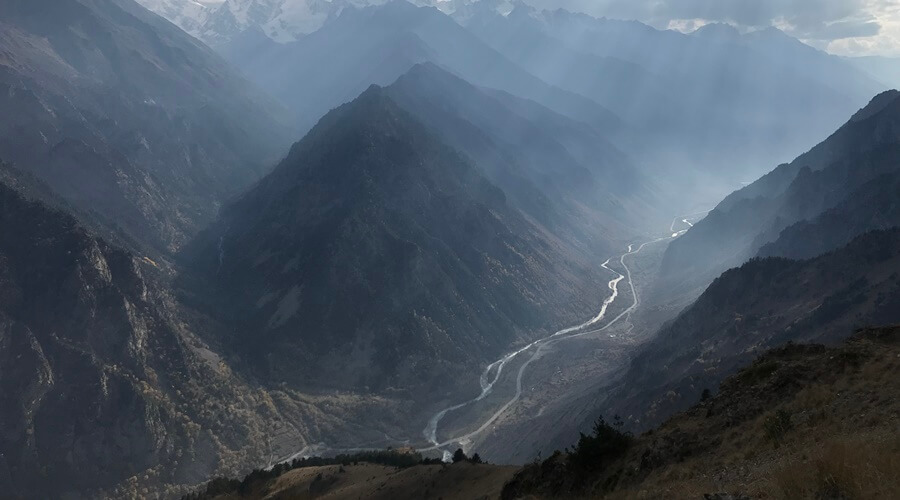
8. What do I need border zone passes to visit?
In Russia, any area within 5-10 km of a neighboring country, without a clearly delineated border (i.e. in the mountains) is considered a special border zone, and patrolled by Russian border guards. This area IS accessible to all Russian citizens with their passports, but is NOT legally accessible to foreign citizens UNLESS you have a special permit from the FSB (Federal Security Bureau). These permits are accessible, either through a tour operator or local friend, but require you to submit your application 45-60 days in advance.
Areas in Kabardino-Balkaria that are worth a visit if you have a border zone pass:
A. Bezengi Wall – This is at the end of the Bezengi Valley, and holds a place of lore among Russian mountain climbers. Many mountain guides go through training in this valley. Five of the Caucasus Mountain’ range’s highest seven peaks are a part of the Bezengi Wall, so you can imagine the draw it has for climbers. There are great areas for trekking and camping in this area.
B. Adyr-Suu Gorge – This remote valley runs perpendicular to Baksan Valley and is about 25 minutes from the base of Mt. Elbrus. It’s marked at the entrance by a relic of the past, a car lift from Soviet days that auto-cranks your car (and you) about 50 meters up the mountain. After 45-60 minutes of driving on gravel road, the gorge opens up into a flat valley with a beautiful view of the surrounding mountains. The Adyr-Suu Alpine Lodge is at the end of this valley and where back-country skiers base out of during the acclimatization phase of their Mt. Elbrus ski tours. This is truly a place where you can experience untouched powder!
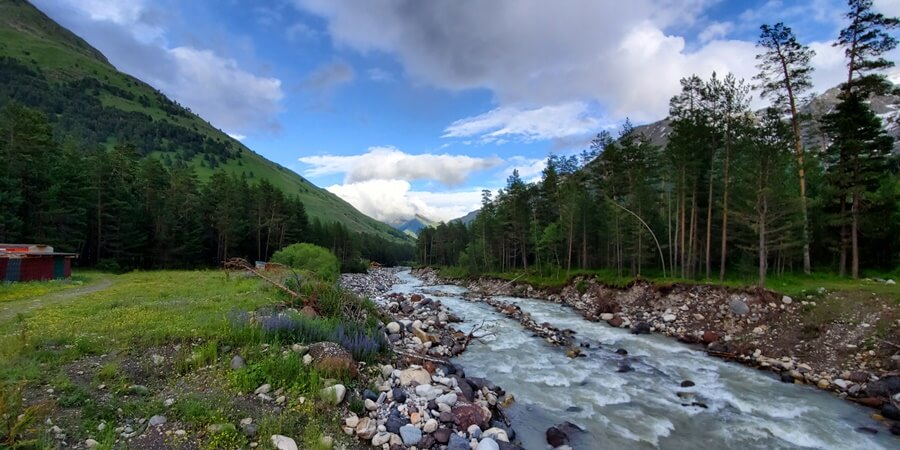
C. Mt. Cheget (Elbrus) – Cheget is a neighboring mountain to Mt. Elbrus and where many climbers will acclimatize, both at its base and while doing some hikes. It also is famous in Russia for its free-ride terrain for more experienced skiers. Standard access to the chair lifts and mountain are available to all (i.e. mountain climbers don’t need to worry about accidentally crossing into the zone), but anyone wanting to summit the peak of Cheget OR visit the beautiful Cheget Lake needs a border permit.

Foreigners violating the border zone areas is considered a serious offense in Russia; make sure to do your due diligence if wanting to visit one of these areas! We highly recommend using a local tour operator and always traveling with a local person if visiting one of these areas.
9. Any cultural “do’s” or “don’t’s” to be aware of
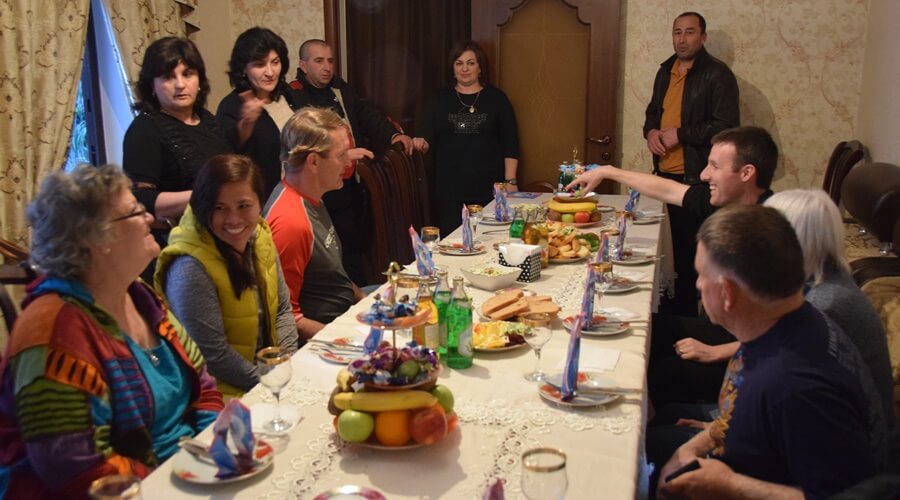
Kabardino-Balkaria is a fascinating republic with a combination of traditional and modern society. The more you interact with local people, the more you’ll see a mixture of Muslim faith, post-Soviet mentality, and ancient local traditions all wrapped together.
Kabardians mainly live in the lowlands (Nalchik, Baksan, and lowland villages), while Balkars primarily live in the mountain valleys (Elbrus, Chegem, Upper Balkaria, etc.). There is a large population of Russians in the region as well. Foreigners visit every area of the region regularly, and so local people are used to and will welcome your presence.
Come with an open mind to learn about these peoples, their traditions, and their land. You won’t regret your trip to Kabardino-Balkaria!

***Want to learn more? Here are several self-published resources from the podcast “CaucasTalk” related to Kabardino-Balkaria:
–Travel Tips to Kabardino-Balkaria (audio version of this blog)
–History of Mt. Elbrus (Part 1)
–History of Mt. Elbrus (Part 2)
–Interview with Local Elbrus guide
–Climbing Elbrus: Interview with American guide
–Who are the Kabardians? (Part 1)
–Who are the Kabardians? (Part 2)
–Skiing in the North Caucasus (Elbrus and more)

